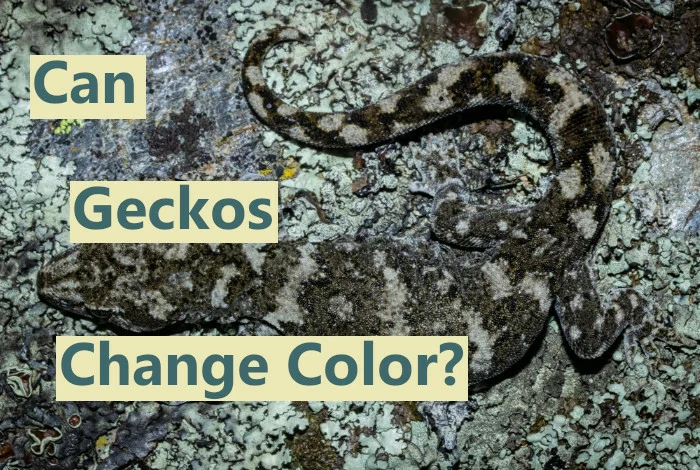Chameleons are famous for changing color, but geckos can do it too. If you’ve watched geckos over time, you might notice them looking lighter or darker than usual. This might make you wonder if geckos have the same color-changing powers as chameleons. Do geckos change color?
Yes, many gecko species can change color, though not as dramatically as chameleons. Geckos usually shift between lighter and darker shades to help with temperature control, camouflage, and communication. The color change is subtle and happens slowly over hours, not instantly like chameleons.
Even though geckos can’t show the rainbow of colors chameleons do, their subtle shifts play an important role in their daily life.
How Geckos Change Color
Geckos change color using special skin cells called chromatophores.
These cells have different pigments. When the cells expand or shrink, they reveal more or less of certain colors, making the gecko look lighter or darker.
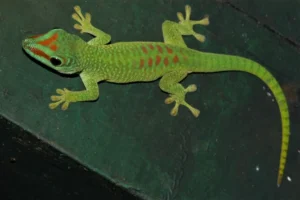
Geckos have several types of chromatophores. Melanophores hold dark brown and black pigments. Xanthophores hold yellow and red pigments. Iridophores reflect light and create blue and green shades.
When a gecko wants to look darker, its melanophores spread out, covering more skin. When it wants to look lighter, these cells shrink, letting the lighter colors underneath show through.
This process is controlled by the gecko’s hormones and nervous system. It’s not a conscious choice like picking clothes. The gecko’s body just reacts automatically to things like temperature, light, and stress.
Color changes in geckos happen much slower than in chameleons. A chameleon can shift colors in seconds, but geckos usually take hours to show noticeable changes.
Why Do Geckos Change Color?
Geckos change color for simple, practical reasons.
Temperature is a big one. Darker colors soak up more heat, while lighter colors reflect it. Many geckos get darker in the morning to warm up faster and lighter in the hottest part of the day to stay cool.
Camouflage is another reason. A gecko that matches its background is less likely to get noticed by predators. Sitting on dark bark? It might darken. On a pale wall? It might lighten.

Communication also matters. Some geckos change color to show mood or social status. A stressed gecko might darken, while a relaxed gecko looks lighter. Males sometimes show brighter colors during breeding to attract females.
Time of day affects color too. Many geckos active at night are darker then and lighter during the day when they rest. This helps them blend with different lighting.
Which Gecko Species Can Change Color?
Not all geckos can change color, but many can, at least a little.
Crested geckos are well-known color changers. They can go from dark brown or gray at night to pale cream or tan during the day. If you watch them closely, it’s easy to see.
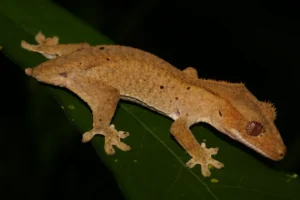
Gargoyle geckos, close relatives of crested geckos, change color the same way. They look darker at night and lighter during the day.
Tokay geckos can shift the intensity of their colors. Their blue-gray and orange spots stay, but sometimes they look bright and vivid, other times more muted.

Leopard geckos have subtler changes. Their patterns stay the same, but the background color can go lighter or darker depending on temperature and time of day.
House geckos can change too, though it’s easy to miss. They go from almost see-through pale to darker gray or brown depending on their surroundings and activity.
To make it easier, here’s a table of 15 common gecko species, showing which ones can change color, how, and why:
| Gecko Species | Can Change Color? | Type of Color Change | Reason for Color Change |
|---|---|---|---|
| Leopard Gecko (Eublepharis macularius) | No (slight) | Minor darkening/lightening | Temperature, mood, stress |
| Crested Gecko (Correlophus ciliatus) | Yes | Brightness and pattern shift | Camouflage, mood, temperature, social signaling |
| Tokay Gecko (Gekko gecko) | Yes | Darker or lighter spots | Stress, aggression, environmental changes |
| Gargoyle Gecko (Rhacodactylus auriculatus) | Yes | Pattern and shade changes | Camouflage, temperature, mood |
| Day Gecko (Phelsuma spp.) | Yes | Brightness and hue shifts | Camouflage, temperature, social signaling |
| Mediterranean House Gecko (Hemidactylus turcicus) | Yes (subtle) | Pale or darker grey | Temperature, stress, light conditions |
| African Fat-Tailed Gecko (Hemitheconyx caudicinctus) | No (slight) | Slight darkening | Temperature, activity level |
| Satanic Leaf-Tailed Gecko (Uroplatus phantasticus) | Yes | Pattern blends with environment | Camouflage (predator avoidance) |
| New Caledonian Gecko (Rhacodactylus leachianus) | Yes | Darker or lighter shades | Camouflage, mood, temperature |
| Mourning Gecko (Lepidodactylus lugubris) | No | Minimal | Mostly fixed coloration |
| Tokay Subspecies (Gekko g. gecko) | Yes | Darkening or lightening of spots | Stress, aggression, environmental adaptation |
| Flat-Tailed Gecko (Uroplatus spp.) | Yes | Pattern and brightness shift | Camouflage, mimicry of leaves/bark |
| African Day Gecko (Lygodactylus spp.) | Yes | Brightness and hue adjustments | Camouflage, temperature, mood |
| Pachydactylus Geckos | No (slight) | Slight shade changes | Temperature and light level |
| Bibron’s Gecko (Chondrodactylus bibronii) | No (slight) | Minor darkening/lightening | Temperature, stress |
Geckos change color slowly, not instantly like chameleons.
Most take hours to show a noticeable shift. A crested gecko might be dark at night but won’t lighten until it’s been resting a few hours during the day.
Research on gecko color timing shows that this usually follows circadian rhythms (the body’s natural 24-hour cycles). Geckos don’t think about changing color. Their body does it automatically based on time of day and environment.
Some changes can be faster. A stressed or threatened gecko might darken within an hour. But lightening usually takes longer, sometimes half a day or more.
Temperature can speed things up. A cold gecko might darken quickly when it warms up.
Even at its fastest, gecko color change is slow compared to chameleons, which can change colors in under a minute.
Geckos vs. Chameleons: Color Change Differences
Both geckos and chameleons can change color, but very differently.
Chameleons are the masters. They can show reds, yellows, blues, and greens, often all at once. Their color changes happen fast and can show emotions and intentions.
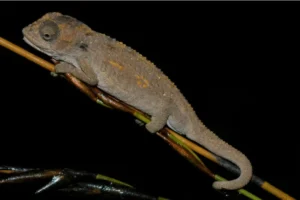
Geckos are more limited. They usually just go lighter or darker shades of their base color. A brown gecko becomes light or dark brown, not blue or green.
Chameleons mainly change color for communication. They signal aggression, submission, courtship, and stress.
Geckos change color mainly for practical reasons like temperature control and camouflage. It’s about survival and comfort, not complex messages.
Speed is different too. Chameleons can flash colors in seconds. Geckos take hours to show changes.
Both use chromatophores, but chameleons have more types and can control them better. That’s why their colors are so bright and varied.
Do Pet Geckos Change Color?
If you keep geckos, you might notice color shifts in their enclosure.
Crested and gargoyle geckos show the clearest changes. Dark at night when active, lighter during the day when resting.
Leopard geckos in captivity show subtler changes based on temperature. Basking under a heat lamp? Slightly lighter. In a cool hide? Slightly darker.
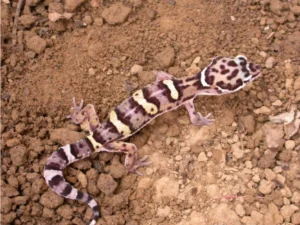
These color changes are normal and healthy. It’s just the gecko’s body responding to light, temperature, and daily routine.
Some owners worry when their gecko looks different at different times, but it’s usually fine. As long as the gecko is eating and acting normally, the colors are fine.
If your gecko suddenly looks pale, washed out, or stays dark all the time, that could mean stress, illness, or environmental problems. Check temperature, humidity, and lighting.
What Affects a Gecko’s Color?
Several things affect gecko color at any moment.
- Light is big. Geckos are lighter in bright light and darker in dim conditions. This helps them blend in.
- Temperature matters. Cold geckos look darker to soak up heat. Warm geckos lighten to avoid overheating.
- Stress can darken a gecko. Feeling threatened, sick, or uncomfortable? Expect darker colors.
- Breeding season can affect color. Males may show brighter colors to attract females. Females can change too when ready to breed.
- Age matters. Babies often look different from adults. Colors can intensify or fade as geckos grow. Some species lose color brightness with age.
- Background matters for camouflage. A gecko on a dark surface might darken, on a light one might lighten.
Can Geckos Choose Their Color?
Geckos don’t choose their color like picking a shirt.
Color change is automatic, controlled by their nervous system and hormones. They don’t think “I’ll be darker now.” Their body senses light, temperature, and stress, and responds.
It’s like how you don’t control your pupils getting bigger in dim light, or skin getting goosebumps when cold. Your body just does it.
Geckos can influence color indirectly. Moving to a warmer spot? They lighten over time. Hiding in dark? They darken. So while they can’t directly pick a color, their location affects it.
Automatic color change helps the gecko. The body handles temperature and camouflage while the gecko focuses on food and staying safe.
Signs of Unhealthy Color Changes
Most color changes are normal, but some can show problems.
Always pale and washed out? Could be stress, too hot, or sick. Check your enclosure and consider a vet.
Always very dark? Could be too cold or stressed. Make sure heating and hiding spots are right.
Unusual colors not normal for your species? Could signal health problems, like liver issues.
Blotchy or uneven colors? Could be skin infection. Normal changes are even across the body.
Colors suddenly dull or faded for a long time? Could be poor nutrition, illness, or wrong lighting. Make sure diet and lighting match your species needs.
Conclusion
Geckos can change color, though not like chameleons. Their shifts are subtle, slow, and help with temperature and camouflage.
Different species have different abilities. Crested geckos show obvious daily changes. Leopard geckos have subtler shifts you might not notice unless you watch closely.
These color changes are usually normal and healthy. They’re just the gecko’s body reacting to the environment and daily cycle.
Understanding that geckos change color helps you appreciate them more and take better care if you keep them. Next time your gecko looks different, don’t worry. It’s probably just doing what geckos naturally do.
Hi, my name is Ezra Mushala, i have been interested animals all my life. I am the main author and editor here at snakeinformer.com.

